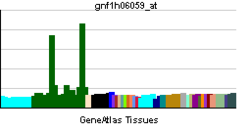- DPP10
-
Dipeptidyl-peptidase 10 (non-functional) Identifiers Symbols DPP10; DPL2; DPPY; DPRP3 External IDs OMIM: 608209 MGI: 2442409 HomoloGene: 41400 GeneCards: DPP10 Gene Gene Ontology Molecular function • serine-type peptidase activity
• dipeptidyl-peptidase activityCellular component • membrane fraction
• membrane
• integral to membraneBiological process • proteolysis Sources: Amigo / QuickGO RNA expression pattern 

More reference expression data Orthologs Species Human Mouse Entrez 57628 269109 Ensembl ENSG00000175497 ENSMUSG00000036815 UniProt Q8N608 Q6NXK7 RefSeq (mRNA) NM_001004360.3 NM_199021.3 RefSeq (protein) NP_001004360.2 NP_950186.3 Location (UCSC) Chr 2:
115.2 – 116.6 MbChr 1:
125.23 – 125.94 MbPubMed search [1] [2] Inactive dipeptidyl peptidase 10 is a protein that in humans is encoded by the DPP10 gene.[1][2][3]
This gene encodes a single-pass type II membrane protein that is a member of the S9B family in clan SC of the serine proteases. This protein has no detectable protease activity, most likely due to the absence of the conserved serine residue normally present in the catalytic domain of serine proteases. However, it does bind specific voltage-gated potassium channels and alters their expression and biophysical properties. Mutations in this gene have been associated with asthma. Alternate transcriptional splice variants, encoding different isoforms, have been characterized.[3]
References
- ^ Nagase T, Kikuno R, Ishikawa K, Hirosawa M, Ohara O (Sep 2000). "Prediction of the coding sequences of unidentified human genes. XVII. The complete sequences of 100 new cDNA clones from brain which code for large proteins in vitro". DNA Res 7 (2): 143–50. doi:10.1093/dnares/7.2.143. PMID 10819331.
- ^ Qi SY, Riviere PJ, Trojnar J, Junien JL, Akinsanya KO (Jun 2003). "Cloning and characterization of dipeptidyl peptidase 10, a new member of an emerging subgroup of serine proteases". Biochem J 373 (Pt 1): 179–89. doi:10.1042/BJ20021914. PMC 1223468. PMID 12662155. http://www.pubmedcentral.nih.gov/articlerender.fcgi?tool=pmcentrez&artid=1223468.
- ^ a b "Entrez Gene: DPP10 dipeptidyl-peptidase 10". http://www.ncbi.nlm.nih.gov/sites/entrez?Db=gene&Cmd=ShowDetailView&TermToSearch=57628.
Further reading
- Yamada R, Ymamoto K (2005). "Recent findings on genes associated with inflammatory disease". Mutat. Res. 573 (1–2): 136–51. doi:10.1016/j.mrfmmm.2004.06.061. PMID 15829243.
- Strausberg RL, Feingold EA, Grouse LH et al. (2003). "Generation and initial analysis of more than 15,000 full-length human and mouse cDNA sequences". Proc. Natl. Acad. Sci. U.S.A. 99 (26): 16899–903. doi:10.1073/pnas.242603899. PMC 139241. PMID 12477932. http://www.pubmedcentral.nih.gov/articlerender.fcgi?tool=pmcentrez&artid=139241.
- Chen T, Ajami K, McCaughan GW et al. (2003). "Dipeptidyl peptidase IV gene family. The DPIV family". Adv. Exp. Med. Biol.. Advances in Experimental Medicine and Biology 524: 79–86. doi:10.1007/0-306-47920-6_10. ISBN 0-306-47717-3. PMID 12675227.
- Allen M, Heinzmann A, Noguchi E et al. (2003). "Positional cloning of a novel gene influencing asthma from chromosome 2q14". Nat. Genet. 35 (3): 258–63. doi:10.1038/ng1256. PMID 14566338.
- Ota T, Suzuki Y, Nishikawa T et al. (2004). "Complete sequencing and characterization of 21,243 full-length human cDNAs". Nat. Genet. 36 (1): 40–5. doi:10.1038/ng1285. PMID 14702039.
- Jerng HH, Qian Y, Pfaffinger PJ (2005). "Modulation of Kv4.2 channel expression and gating by dipeptidyl peptidase 10 (DPP10)". Biophys. J. 87 (4): 2380–96. doi:10.1529/biophysj.104.042358. PMC 1304660. PMID 15454437. http://www.pubmedcentral.nih.gov/articlerender.fcgi?tool=pmcentrez&artid=1304660.
- Gerhard DS, Wagner L, Feingold EA et al. (2004). "The status, quality, and expansion of the NIH full-length cDNA project: the Mammalian Gene Collection (MGC)". Genome Res. 14 (10B): 2121–7. doi:10.1101/gr.2596504. PMC 528928. PMID 15489334. http://www.pubmedcentral.nih.gov/articlerender.fcgi?tool=pmcentrez&artid=528928.
- Zagha E, Ozaita A, Chang SY et al. (2005). "DPP10 modulates Kv4-mediated A-type potassium channels". J. Biol. Chem. 280 (19): 18853–61. doi:10.1074/jbc.M410613200. PMID 15671030.
- Ren X, Hayashi Y, Yoshimura N, Takimoto K (2005). "Transmembrane interaction mediates complex formation between peptidase homologues and Kv4 channels". Mol. Cell. Neurosci. 29 (2): 320–32. doi:10.1016/j.mcn.2005.02.003. PMID 15911355.
- Chen T, Ajami K, McCaughan GW et al. (2006). "Molecular characterization of a novel dipeptidyl peptidase like 2-short form (DPL2-s) that is highly expressed in the brain and lacks dipeptidyl peptidase activity". Biochim. Biophys. Acta 1764 (1): 33–43. doi:10.1016/j.bbapap.2005.09.013. PMID 16290253.
- Takimoto K, Hayashi Y, Ren X, Yoshimura N (2006). "Species and tissue differences in the expression of DPPY splicing variants". Biochem. Biophys. Res. Commun. 348 (3): 1094–100. doi:10.1016/j.bbrc.2006.07.157. PMID 16899223.
- Jerng HH, Lauver AD, Pfaffinger PJ (2007). "DPP10 splice variants are localized in distinct neuronal populations and act to differentially regulate the inactivation properties of Kv4-based ion channels". Mol. Cell. Neurosci. 35 (4): 604–24. doi:10.1016/j.mcn.2007.03.008. PMID 17475505.
- Hersh CP, Raby BA, Soto-Quirós ME et al. (2007). "Comprehensive testing of positionally cloned asthma genes in two populations". Am. J. Respir. Crit. Care Med. 176 (9): 849–57. doi:10.1164/rccm.200704-592OC. PMC 2048676. PMID 17702965. http://www.pubmedcentral.nih.gov/articlerender.fcgi?tool=pmcentrez&artid=2048676.
Categories:- Human proteins
- Chromosome 2 gene stubs
Wikimedia Foundation. 2010.
